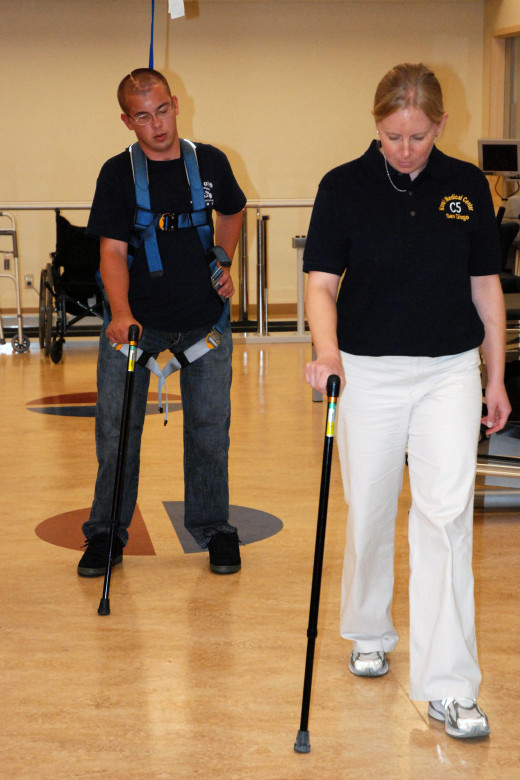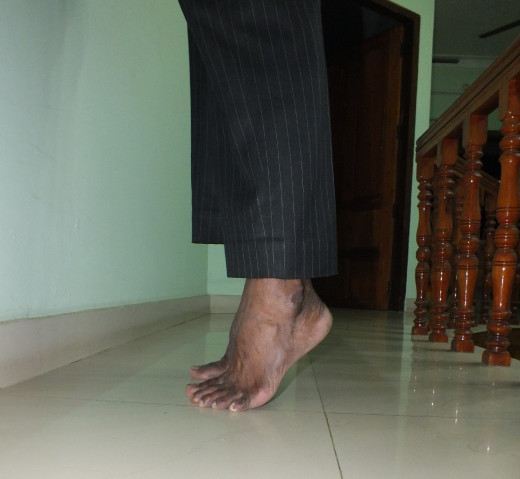Gait Training – Physiotherapy Management #1

Introduction
The exercises in the standing position are specially designed to provide re-education in walking. It is advisable to perform these exercises in a spacious ventilated room for convenience. In this article we shall discuss some of the exercises which are essential for gait training

1. Two Leg Balancing Exercise
The patient stands relaxed with the feet together by the sides or a little apart with the hands hanging down and facing the wall of a room. Now turn the head towards the right and hold the head in the maximum turned position for 2 seconds. Now bring back the head to the starting position. Now turn the head towards the left and then hold the head in the maximum turned position for 2 seconds. Now bring back the head to the starting position. To start with the exercise is done slowly and smoothly and then make it faster progressively. Repeat the exercise 5-6 times at a time, twice a day. While doing the exercise, in case he loses his balance, he can touch the wall with one or both hands so that he can maintain the balance without falling.
This exercise can be modified by lifting the head up so as to look at the ceiling and then bringing it down so as to touch the chest with the chin.

2. One Leg Balance Exercise
The patient stands relaxed with the feet together by the sides or a little apart with the hands hanging down and facing the wall of a room. Now sway towards left and transfer the body weight to the left leg, so that the right leg is free to move. Now bend the right leg at the hip and knee so that the right leg is off the ground. Now the patient stands on the left leg. Maintain balance and stand on the left leg for 2-3 seconds. Repeat the exercise with the other leg. Transferring of the body weight to one leg and lifting the other leg of the ground must be done slowly and in a rhythmic way. Repeat the exercise 5-6 times twice a day. While doing the exercise, in case he loses the balance, he can touch the wall with one or both hands so that he can maintain the balance without falling.


3. Heel/Toe Standing
The patient stands relaxed with the feet together by the sides or a little apart with the hands hanging down and facing the wall of a room. Now the patient stands on the toes for 2 seconds. Slowly he comes down flat on the ground. Now the patient stands on the heels for 2 seconds. Now return back to the starting position. Repeat the exercise 5-6 times, twice a day. Throughout the exercise he must maintain balance. While doing the exercise, in case he loses the balance, he can touch the wall with one or both hands so that he can maintain the balance without falling.

4. Standing Balance Exercise 1
The patient stands relaxed with the feet together by the sides or a little apart with the hands hanging down. The physiotherapist sits on a stool in front of the patient. He places the palmar aspects of his hands on either side of the anterior aspect of the pelvis. A ‘pushing force ‘is applied on either side of the anterior aspect of the pelvis. The patient is instructed to hold the body ‘tight’ without moving irrespective of the ‘pushing force’ applied. The force is applied continuously for 5 seconds and then released slowly. Repeat the exercise 5-6 times, twice a day.

5. Standing Balance Exercise 2
The patient stands relaxed with the feet together by the sides or a little apart with the hands hanging down. The physiotherapist sits on a stool in front of the patient. He places the palmar aspects of his hands on either side of the posterior aspect of the pelvis. A ‘pulling force’ is applied on either side of the posterior aspect of the pelvis. The patient is instructed to hold the body ‘tight’ without moving irrespective of the ‘pulling force’ applied. This force is applied continuously 5 seconds and then released slowly till the starting position is attained. Repeat the exercise 5-6 times, twice a day.

6. Standing Balance Exercise 3
The patient stands relaxed with the feet together by the sides or a little apart with the hands hanging down. The physiotherapist sits on a stool in front of the patient. He places the palmar aspect of his right hand on left side of the anterior aspect of the pelvis and the palmar aspect of his left hand on the right side of the posterior aspect of the pelvis. A ‘pushing force’ is applied on the left side of the anterior aspect of the pelvis by the physiotherapist’s right hand and a ‘pulling force’ is applied on the right side of the posterior aspect of the pelvis by the physiotherapist’s left hand. The ‘pushing force’ and the ‘pulling force’ are applied simultaneously. Because of these two forces, the patient’s body has a tendency to rotate. But the patient is instructed to hold the body ‘tight’ without moving irrespective of the forces applied. These forces are applied continuously for 5 seconds and then released slowly. Repeat the exercise 5-6 times, twice a day. This exercise can be done in the opposite directions also.

7. Standing Balance Exercise 4
The patient stands relaxed with the feet together by the sides or a little apart with the hands hanging down. The physiotherapist sits on a stool in front of the patient. He places the palmar aspect of his right hand on the left side of the pelvis of the patient. A ‘pushing force’ is applied to the left lateral side of the pelvis of the patient. The patient is instructed to hold the body ‘tight’ without moving irrespective of the ‘pushing force’ applied. This force is applied continuously for 5 seconds and then released slowly. Repeat the exercise on the other side. Repeat the exercise 5-6 times, twice a day.

8. Standing Balance Exercise 5
The patient stands relaxed with the feet together by the sides or a little apart with the hands hanging down. The physiotherapist stands in front of the patient facing him. The physiotherapist places the palmar aspects of his hands on the anterior aspects of the shoulders of the patient, one hand on each shoulder. A ‘pushing force’ is applied on the anterior aspects of the shoulders of the patient simultaneously. The patient is instructed to hold the body ‘tight’ without moving irrespective of the ‘pushing force’ applied. The force is applied continuously for 5 seconds and then released slowly. Repeat the exercise 5-6 times, twice a day.

9. Standing Balance Exercise 6
The patient stands relaxed with the feet together by the sides or a little apart with the hands hanging down. The physiotherapist stands in front of the patient facing him. The physiotherapist places the palmar aspects of his hands on the posterior aspects of the shoulders, one hand on each shoulder. A ‘pulling force ‘is applied on the posterior aspects of the shoulders of the patient simultaneously. The patient is instructed to hold the body ‘tight’ without moving irrespective of the ‘pulling force’ applied. The force is applied continuously for 5 seconds and then released slowly. Repeat the exercise 5-6 times, twice a day.

10. Standing Balance exercise 7
The patient stands relaxed with the feet together by the sides or a little apart with the hands hanging down. The physiotherapist stands in front of the patient facing him. The physiotherapist places the palmar aspect of his right hand on the lateral side of the left shoulder of the patient. A ‘pushing force’ is applied on the lateral side of the left shoulder of the patient. The patient is instructed to hold the body ‘tight’ without moving irrespective of the ‘pushing force ‘applied. The force is applied continuously for 5 seconds and then released slowly. Repeat the exercise 5-6 times, twice a day. Do the exercise with the other side also.

11. Standing Balance Exercise 8
The patient stands relaxed with the feet together by the sides or a little apart with the hands hanging down. The physiotherapist stands in front of the patient facing him. The physiotherapist places the palmar aspect of his right hand on the anterior aspect of the left shoulder of the patient and the palmar aspect of his left hand on the posterior aspect of the right shoulder of the patient. A ‘pushing force ‘is applied on the anterior aspect of the left shoulder and a ‘pulling force’ is applied on the posterior aspect of the right shoulder. Both the forces are applied simultaneously. The patient is instructed to hold the body ‘tight’ without moving irrespective of the forces applied. The force is applied continuously for 5 seconds and then slowly released. Repeat the exercise 5-6 times, twice a day. Do the exercise in the other way round also.

12. Standing Balance Exercise 9
The patient stands relaxed with the feet together by the sides or a little apart with the hands hanging down. The physiotherapist stands in front of the patient facing him. The physiotherapist places the palmar aspect of his right hand on the forehead of the patient. A ‘pushing force’ is applied on the forehead. The patient is instructed to hold the head and the body ‘tight’ without moving irrespective of the ‘pushing force’ applied. The force is applied continuously for 5 seconds and then slowly released. Now repeat the exercise by giving a ‘pulling force’ on the posterior aspect of the head and also by giving ‘pushing forces’ on the lateral sides of the head.
Repeat the exercise 5-6 times, twice a day

13. Standing Balance Exercise 10
The patient stands relaxed with the feet together by the sides or a little apart with the hands hanging down. The physiotherapist stands in front of the patient facing him. The physiotherapist places the palmar aspect of his right hand on the anterior aspect of the left shoulder of the patient and the palmar aspect of his left hand on the posterior aspect of the pelvis on the right side of the patient. A ‘pushing force’ is applied on the anterior aspect of the left shoulder of the patient and a ‘pulling force’ is applied on the posterior aspect of the pelvis on the right side of the patient. Both the forces are applied simultaneously. The patient is instructed to hold the body ‘tight’ without moving irrespective of the forces applied. These forces are applied continuously for 5 seconds and then slowly released. Do the exercise 5-6 times, twice a day. Do the exercise in the other way round also.







